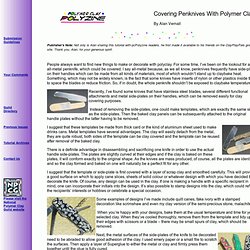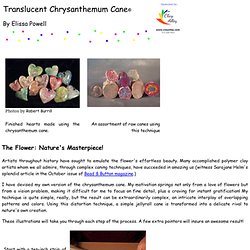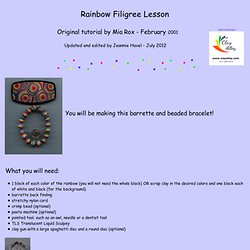

Covering Penknives With Polymer Clay. People always want to find new things to make or decorate with polyclay.

For some time, I’ve been on the lookout for an all-metal penknife, which could be covered. I say all-metal because, as we all know, penknives frequently have side-plates on their handles which can be made from all kinds of materials, most of which wouldn’t stand up to claybake heat. Something, which may not be widely known, is the fact that some knives have inserts of nylon or other plastics inside them to space the blades or reduce friction.
So, if in doubt, the whole penknife shouldn’t be exposed to claybake temperatures. Recently, I’ve found some knives that have stainless steel blades, several different functional attachments and metal side-plates on their handles, which can be removed easily for clay covering purposes. Instead of removing the side-plates, one could make templates, which are exactly the same size as the side-plates. Finally, apply a good varnish. Chrysanthemum Cane. The Flower: Nature's Masterpiece!

Artists throughout history have sought to emulate the flower's effortless beauty. Many accomplished polymer clay artists whom we all admire, through complex caning techniques, have succeeded in amazing us (witness Sarajane Helm's splendid article in the October issue of Bead & Button magazine.) I have devised my own version of the chrysanthemum cane. My motivation springs not only from a love of flowers but from a vision problem, making it difficult for me to focus on fine detail, plus a craving for instant gratification! My technique is quite simple, really, but the result can be extraordinarily complex, an intricate interplay of overlapping patterns and colors. These illustrations will take you through each step of the process. Extra Tips 1. 2. 3. 4. 5. 6. Cane Theory. Vessels With An Attitude. Mosaic Cane.
Scrap Clay Bargello. CD Sparkle Barrette. Remember those old recipes (from the 60s or earlier) with unusual ingredients, like chocolate cake made with sauerkraut, Jello with cabbage in it, and spice cake made with tomato soup?

Well this project is a little bit like those—weird-sounding but tasty. What can you make using black clay, a CD-R, a dog collar, and floor finish? Scratching your head? Well, don’t mess up your hair—you’re going to want it to look nice with your new barrettes. That’s right, barrettes! Troll Sculpture-Part 1. Troll (Norwegian): n.

A very large creature seen in the woods of Norway. Living in caves in the mountains, with rooms full of gold and silver. Well known to capture the oldest princess for some hero to rescue. Sculpting a troll face is not that difficult, mainly because the proportions don’t have to be as accurate as when sculpting a human being. You can make funny faces and big noses, and they still look like that's what they were meant to be. This head measures 2 inches (5cm) and his full body around 10 inches (25cm).
Materials for making the head: Foil Flesh colored, black, white and translucent blue polymer clay (I've used Fimo Soft clay) Sobo or TLS (attaching unbaked to baked clay) Pasta machine or brayer Sharp cutting blade Knitting and wool/yarn needles Brushes Acrylic antique medium, light pink and red-orange acrylic paint Matt and glossy polymer clay varnish Aleene's Tacky glue Sheep wool for hair Wire or other decorations for jewelry. Rainbow Filigree. Original tutorial by Mia Rox - February 2001 Updated and edited by Jeannie Havel - July 2012 You will be making this barrette and beaded bracelet!

What you will need: 1 block of each color of the rainbow (you will not need the whole block) OR scrap clay in the desired colors and one block each of white and black (for the background).